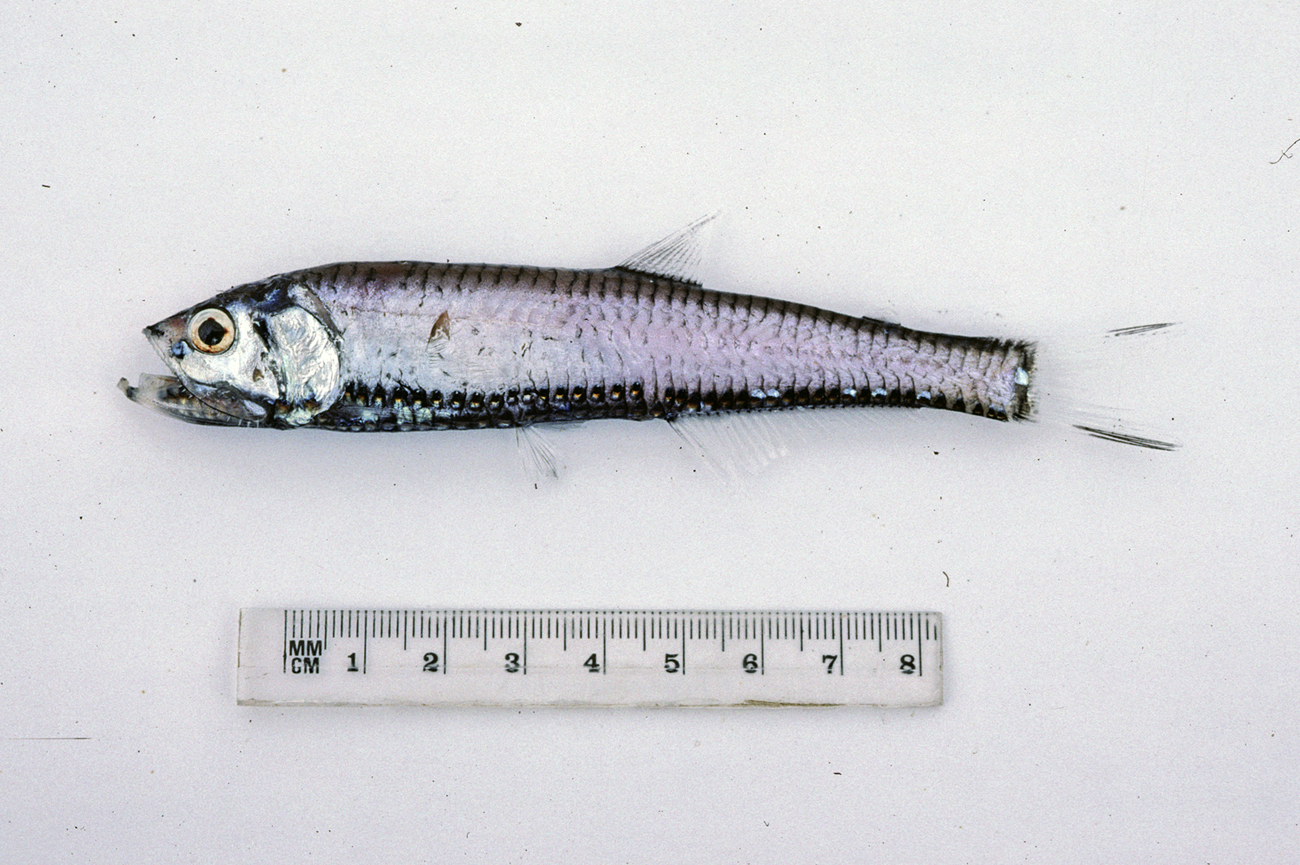- Classification
- ACTINOPTERYGII
- STOMIIFORMES
- PHOSICHTHYIDAE
- Polymetme
- corythaeola
Rendezvous Fish, Polymetme corythaeola (Alcock 1898)

A Rendezvous Fish, Polymetme corythaeola, from ESE of Kiama, New South Wales, July 1985, FRV Kapala, depth 439 m. Source: Ken Graham, NSW Fisheries / iNaturalist.org. License: CC by Attribution-NonCommercial
Summary:
A lightfish with a dark grey back, silver sides and black below, with black bars on the scale pockets, black pigment on the outer rays of the caudal fin and two ventral rows of photophores along the body.
Cite this page as:
Bray, D.J. 2021, Polymetme corythaeola in Fishes of Australia, accessed 20 Apr 2024, https://fishesofaustralia.net.au/home/species/3399
Rendezvous Fish, Polymetme corythaeola (Alcock 1898)
More Info
|
Distribution |
Coral Sea, SE of Cairns, Queensland, around southern Australia to the Northwest Shelf, Western Australia, and possibly further north to off Cartier Reef in the Timor Sea. Elsewhere the species is widespread in the Indo-Pacific from South Africa, Madagascar, the Gulf of Aden, the Andaman Sea, the Maldives, Mascarene Islands, and Japan, south to Australia, New Caledonia and New Zealand. The species is benthopelagic over continental and insular slopes, and seamounts |
|
Features |
Dorsal fin 10–12 + adpipose fin; Anal fin 27–31; Pectoral fin 9–11; Pelvic fin 7; Gill rakers 15–17; Branchiostegal rays 12–14. Photophores: ORB 1, OP 3, SO 1, BR 9–10, IV 21, VAV 7–8, AC 22–23, IC 50–52, OA 9–10. Body elongate and compressed; body depth 15–18% SL; head length 21–26% SL; eye of moderate size, diameter about equal to snout length, eye diameter 4–6% SL; mouth large, oblique, maxillary almost to rear edge of preopercle, premaxillary about half as long as toothed edge of maxillary; 2 rows of small canines at front of upper jaw and one row posteriorly; lower jaw with 2 rows of teeth, outer row larger; vomer and palatine with few teeth; scales cycloid, weakly attached; dorsal adipose fin present; anal fin long, origin below rear of dorsal fin. |
|
Etymology |
The specific name corythaeola is from the Greek korythos (= helmet), and aiolos (quick-moving, nimble, sparkling) from Aiolos, the Greek god of the winds, possibly in reference to the luminous tissue on the head: “the whole crown of the head (from the snout to the occiput) appears to have been luminous”. |
|
Species Citation |
Diplophos corythaeolum Alcock 1898, Annals and Magazine of Natural History 7 2(22): 147. Type locality: Andaman Sea, Investigator station 115, 116 and 233, in 188-220, depth 185 and 405 fathoms. |
|
Author |
Bray, D.J. 2021 |
|
Resources |
Rendezvous Fish, Polymetme corythaeola (Alcock 1898)
References
Alcock, A.W. 1898. Natural history notes from H.M. Indian Marine Survey Ship Investigator, Commander T.H. Heming, R.N., commanding. Series 2(25). A note on the deep-sea fishes with descriptions of some new genera and species including another probably viviparous ophidioid. Annals and Magazine of Natural History 7 2(22): 136-155 See ref at BHL
Harold, A. 2020. Polymetme corythaeola. The IUCN Red List of Threatened Species 2020: e.T18252941A21913518. https://dx.doi.org/10.2305/IUCN.UK.2020-1.RLTS.T18252941A21913518.en. Downloaded on 12 April 2021.
Harold, A.S. & Gomon, M.F. 2008. Family Phosichthyidae Lightfishes, pp. 235-239 in Gomon, M.F., Bray, D.J. & Kuiter, R.H. (eds). Fishes of Australia's Southern Coast. Sydney : Reed New Holland 928 pp.
Kenaley, C.P. & Stewart, A.L. 2015. Families Diplophidae, Gonostomatidae, Phosichthyidae. pp. 420-445 in Roberts, C.D., Stewart, A.L. & Struthers, C.D. The Fishes of New Zealand. Wellington : Te Papa Press Vol. 2 pp. 1-576.
Norman, J.R. 1930. Oceanic fishes and flatfishes collected in 1925–1927. Discovery Reports 2: 261-370 figs 1-47 pls 1-2 (Polymetme corythaeola and P. illustris - the latter considered a junior synonym) See ref at BHL
Parin, N.V. & Borodulina, O.D. 1990. Review of the genus Polymetme (Photichthyidae) with the description of two new species. Voprosy Ikhtiologii 30(5): 733-743 (in Russian)
Young, J.W., Lamb, T.D & Bradford, R.W. 1996. Distribution and community structure of midwater fishes in relation to the subtropical convergence off eastern Tasmania, Australia. Marine Biology 126(4): 571-584.



